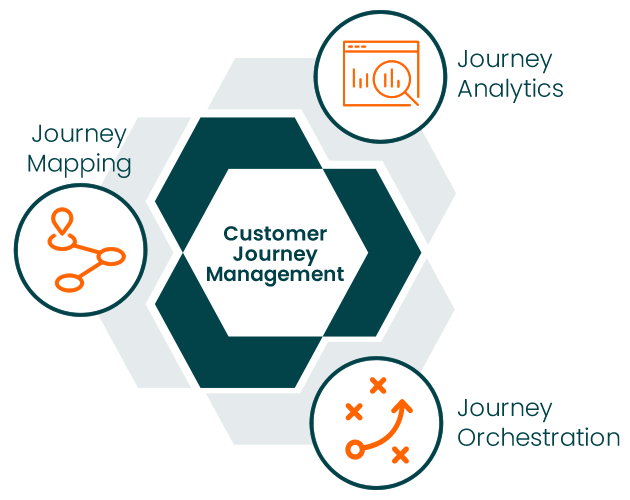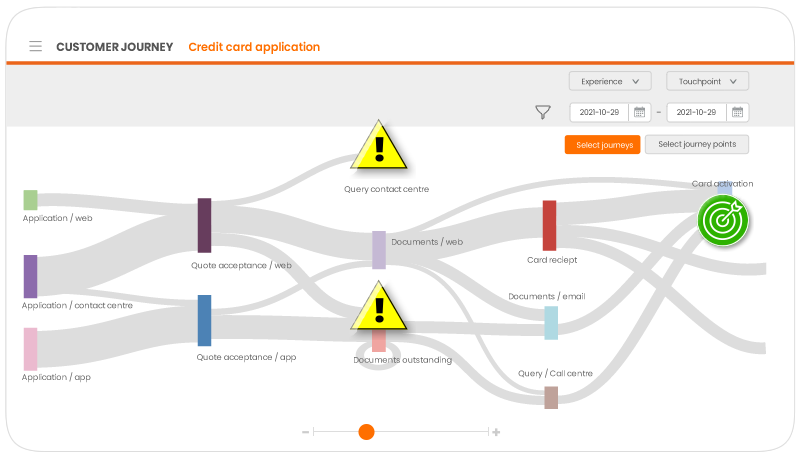Getting up and running with the Next Evolution of Customer Experience

Customer Journey Management is the process of discovering and optimizing your customers’ journeys as they interact with your brand, to improve customer experience and achieve positive business outcomes. It’s an ongoing practice rather than a discreet project and offers a proven solution to customer experience and profitability for the customer-centric business.
Hold on – a “solution to customer experience”? Isn’t CX its own solution to customer experience? Today, your customers are more self-empowered and unpredictable than ever before and being good at CX is no longer enough. According to Forrester’s CX Index, 81% of brands have reported stagnant growth from their CX investment in recent years1.
“Journey management enables you not only to measure, monitor and optimize customer experience, but align your entire organization with your customers’ goals.” 2
CustomerThink
Journey Management solutions and tools empower today’s CX professionals to achieve the following:
- To easily discover customers’ actual journeys and pitfalls through easy visualizations of existing data
- To measure customers’ sentiment and gather their emotional context throughout their journeys
- To uncover the ‘why’ behind customer behavior
- To optimize journeys by orchestrating real-time, personal nudges and interventions
- To measure ROI and the impact of strategies, and fine-tune to further optimize
Is Journey Management really important?
More than ever, customers interact with organizations on journeys that cut across touchpoints, often managed by different functions. As such, their journeys are multi-touch, omni-channel and cross functional. A journey-first focus will lead businesses to an understanding of the end-to-end customer journey rather than the isolated customer experiences of traditional CX. Customers can be guided personally and contextually depending upon their behavior and goals.
But what is the real impact of being journey-centric?
McKinsey & Co. have reported that more than half of customer interactions happen during multi-event, multi-channel journeys3. They’ve also found that a journey focus is 30% more strongly correlated with your important business metrics (such as likelihood to stay, and satisfaction). Research by the Aberdeen Group uncovered that customer win-back rates improved 14X, and revenue from referrals improved 3X following the implementation of an effective customer journey management framework4.
Today’s leading businesses are turning to dynamic, data-driven journey management to increase customer conversion, grow acquisition, ensure customer retention, accelerate real-time customer insight and grow business revenue. At inQuba we’ve seen a doubling of customer conversion and an improvement in customer experience within weeks!
Customer Journey Management
Customer Journey Management is the discovery and analysis of customers’ actual journeys, called Journey Analytics, and the optimization of customer journeys for success, referred to as Journey Orchestration. Journey Management is often confused with traditional journey mapping. While there is some overlap between journey management and journey mapping, they are fundamentally different practices.

Customer Journey Mapping
 |
Source: www.columbiaroadcom.medium.com/ |
Journey mapping is often the initial step a business takes when it wants to improve customer experience. Internal stakeholders model the processes and steps that they expect their customers to take. Lines are drawn and stickies are stuck. Maps sometimes include touchpoints and responsibilities, and even an assumed indication of customers’ emotional state at each step. The output is a static visualization of the customers’ paths across touchpoints as they attempt to reach their goals. It’s an important first step to understanding and improving the customer experience because it defines customer goals, optimal paths and areas of responsibility. It’s a good starting point. In isolation, though, journey mapping stops short of being actionable, as discussed in our blog The 4 Reasons Your Journey Maps Are Failing You. This is because the maps don’t represent actual customer journeys in the real world, they don’t identify individuals or their goals, and they cannot address the pain points that customers face.
The broader domain of journey management succeeds in turning static maps into real-world, data-driven journey visualizations, understanding individual customers’ context, goals and feelings, and addressing the obstacles that customers encounter in real time. So how do we discover actual journeys?
Customer Journey Analytics
 You know the destination you want your customers to reach. Unfortunately, the paths to using your product or service are sometimes more complex and winding than intended. That’s because obstacles and confusing processes can lead to individuals taking detours and actual journeys become messy and unpredictable, making journeys difficult to see and understand.
You know the destination you want your customers to reach. Unfortunately, the paths to using your product or service are sometimes more complex and winding than intended. That’s because obstacles and confusing processes can lead to individuals taking detours and actual journeys become messy and unpredictable, making journeys difficult to see and understand.
Customer Journey Analytics is data-driven, allowing you to visualize customer behavior and end-to-end customer paths (across channels) by joining the dots in your customers’ transactional and behavioral data. Your customers’ paths are presented as a dynamic, real-time visualization, showing which customers are reaching their goals, dropping away or getting stuck in recursive loops. Sentiment and customer feedback at every point provides an emotional overlay to journeys, ensuring enhanced insight into customer behavior.
Journey analytics answers the following questions:
- What are our customers real journeys, and where are they getting stuck?
- Are we succeeding at delivering value at each step of the customer journey?
- What are our customers experiencing along the path?
- Why are customers dropping away at each point?
- Which are our optimal and sub-optimal paths?
- Which customer cohorts are reaching their goals, and which aren’t?
Having discovered the customer’s journey, behavior and emotion, how will we guide them towards the goals they’re trying to reach?
Customer Journey Orchestration
 Imagine that many customers are stalling during a credit card application process. Despite their goals and strong intent, they’re encountering friction such as confusing processes and a lack of helpful information. They’re losing momentum, stalling, or dropping away. Whether digital experiences or omni-channel, customers need to be helped towards their goals.
Imagine that many customers are stalling during a credit card application process. Despite their goals and strong intent, they’re encountering friction such as confusing processes and a lack of helpful information. They’re losing momentum, stalling, or dropping away. Whether digital experiences or omni-channel, customers need to be helped towards their goals.
Customer Journey Orchestration uses insight into journeys and behavior, and, together with Machine Learning and AI, launches dynamic interventions to reach out when customers need help. The business can guide customer behavior with hyper-personalized, real-time interventions and nudges that boost customer conversion. Journey orchestration results in the optimization of individual customer journeys for success. This is where your journey data is ultimately harnessed for success and revenue growth. When your customers are achieving their goals, you are too.
Today’s customers demand seamless and personalized experiences, and today’s CX practitioners need a flexible toolbox when customers need help. In our card application example, orchestration could include digital nudges (such as a personalized prompt when something is outstanding), a value communication (such as a reminder of a particular benefit), or even personal customer service by introducing a consultant in a contact center.
About inQuba Journey Management
Customer Journey Management is the laser technology of CX. Lasers offer targeting precision for specific use cases. Users have granular control. Similarly, managing customer journeys allows you to focus on the specific – cohorts, behaviors and use cases. Every systematic action is for someone, not everyone.
While CX results are flattening, inQuba Journey Management – the next evolution of CX – is helping businesses to visualize actual journeys, understand their emotion, dynamically clear their paths, nudge them in the right direction and double customer conversion.
inQuba Journey Management is laser-focused CX.
We’d love to understand your business challenges better, and discuss how Journey Management can transform your customers’ experiences and business growth.
How to get up and running
Our experts will guide you through an onboarding plan that includes the following:

1. Defining objectives and success metrics
Whether it’s journey discovery, an uplift in customer conversion, or customer retention, the objectives of your programme will be agreed upon & recorded. Based upon these, the individual sprints will be defined & success metrics selected.

2. Define the journey
It’s important to establish which customer journey/s will be included in the programme, including start & end points. Mapping the journey from the business perspective is a helpful exercise in framing the problem space & providing context.

3. Ask critical questions
Critical questions ensure an understanding of the challenges being faced & will inform solutions. These may include: How do we define a customer drop-off? What types of value should be offered at each step? Which questions should the programme answer?

4. Define dialogues, steps & segments
Dialogues are defined based upon insight collection, & categorized according to the value model (Economic, Functional, Experiential or Symbolic). Service recovery, SLAs and impact evaluations are incorporated, & dialogues are mapped to journey steps & customer segments.

5. Define data, configure & test
The objectives of the programme & the solution design will inform business data requirements & how best to ingest it. The dialogues (interventions & nudges) & rules are then configured & tested to ensure the correct behaviour.

6. Launch!
Defined data is ingested into the inQuba platform & configured dialogues are triggered in response to real customer behaviour. These may include informational updates, sentiment measurements, or nudges to help customers reach their goals.

7. Evaluate & refine
Programme success & intervention effectiveness are evaluated against established objectives & success metrics. These insights will inform the refining of dialogues, transactions, segments & objectives, in order to further enhance optimisation.
References:
- https://www.nctech.org/_files/_pdf/Speaker%20Presentations/Jake-Brody_Accenture_NCTech-Talk.pdf
- https://customerthink.com/what-is-customer-journey-management/
- https://www.slideshare.net/McK_CMSOForum/customer-experience-journey-webinar-v10-091713/
- https://blogs.oracle.com/marketingcloud/post/why-cmos-must-bridge-the-gap-between-love-and-money








